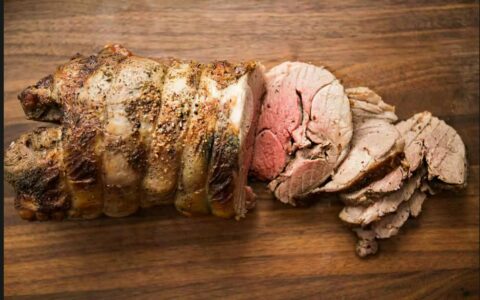Source: http://simplyrecipes.com/recipes/roast_leg_of_lamb-print-photo/
Rating: 9/10

Place lamb and marinade into a plastic bag. Squeeze out as much of the air as possible from the bag and seal. Wrap again with another plastic bag to ensure that the marinating lamb doesn't leak. Marinate for several hours, or overnight, in the refrigerator. Remove the lamb, still in its marinade bag, from the refrigerator at least 30 minutes before putting in the oven to help bring the lamb closer to room temperature before roasting.
Preheat oven to 425°F. Arrange two racks in the oven - a middle rack to hold the lamb, and a lower rack to hold a roasting pan with which to catch the drippings. Place the empty roasting pan in the oven while the oven is pre-heating. Note that this arrangement of racks and pans, with the roast sitting directly on the oven rack, will create a natural convection of heat in the oven, causing the roast to cook more quickly than if cooked the traditional method in a rack in a roasting pan.
Remove the lamb roast from its marinade bag (you may want to temporarily place lamb in another roasting pan, just to make it less messy to work with.) Pat dry the marinade off the lamb with paper towels. Generously salt and pepper all sides of the roast. Arrange fattiest side up, so while the lamb is cooking the fat will melt into the meat. Insert a meat thermometer into the thickest part of the roast, not touching the bone if your roast is bonein. Place directly on middle rack of the oven, with a roasting pan on a separate rack a rung lower, to catch the drippings.
Roast at 425°F for 20 minutes. Then reduce the heat to 300°F and roast an additional hour (for a 6 pound roast), about 10-12 minutes per pound. If you are cooking a roast bone-in, the bone will act as an insulator and will require a longer cooking time than a boneless roast. Note that the method of cooking directly on the oven rack will mimic a convection oven and the cooking time/oven temp needed will be less than you would need if you cooked the roast on a rack in a roasting pan. If you are cooking the roast in a roasting pan, rack or not, start the roast at 450°F and then reduce the heat to 325°F. Also, the shape of the roast will have an impact on the cooking time. Our roast was rather long and thin, so it cooked up fairly quickly. A thicker roast may take longer than expected. At this point start checking the meat thermometer. Note that every time you open the oven door, you'll need 10 minutes or so to bring the oven back up to temperature, thus slowing down the cooking process. So, don't check too often. Remove from the oven anywhere from 130°F to 135°F for medium rare. Lamb should never be cooked until well done or it will be too dry. Let stand for 15-20 minutes before carving. Cut away the kitchen string and slice with a sharp carving knife, 1/2 inch thick slices, against the grain of the meat.
While the roast is resting, use a metal spatula to scrape up the drippings in the roasting pan. Use the drippings to make a gravy, or use just the drippings themselves to serve with the lamb.
